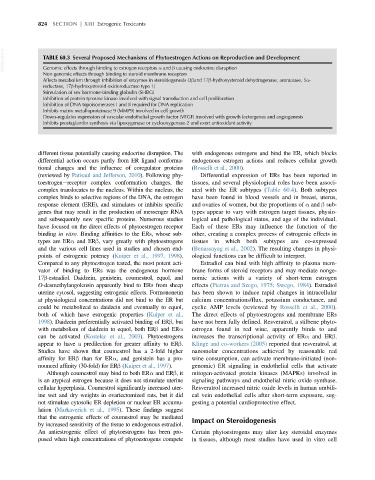Page 866 - Veterinary Toxicology, Basic and Clinical Principles, 3rd Edition
P. 866
824 SECTION | XIII Estrogenic Toxicants
VetBooks.ir TABLE 60.3 Several Proposed Mechanisms of Phytoestrogen Actions on Reproduction and Development
Genomic effects through binding to estrogen receptors α and β causing endocrine disruption
Non-genomic effects through binding to steroid membrane receptors
Affects metabolism through inhibition of enzymes in steroidogenesis (3βand 17β-hydroxysteroid dehydrogenase, aromatase, 5α-
reductase, 17β-hydroxysteroid oxidoreductase type 1)
Stimulation of sex hormone-binding globulin (SHBG)
Inhibition of protein tyrosine kinase involved with signal transduction and cell proliferation
Inhibition of DNA topoisomerases I and II required for DNA replication
Inhibits matrix metalloproteinase 9 (MMP9) involved in cell growth
Down-regulates expression of vascular endothelial growth factor (VEGF) involved with growth factorgenes and angiogenesis
Inhibits prostaglandin synthesis via lipoxygenase or cyclooxygenase-2 and exert antioxidant activity
different tissue potentially causing endocrine disruption. The with endogenous estrogens and bind the ER, which blocks
differential action occurs partly from ER ligand conforma- endogenous estrogen actions and reduces cellular growth
tional changes and the influence of coregulator proteins (Rosselli et al., 2000).
(reviewed by Patisaul and Jefferson, 2010). Following phy- Differential expression of ERs has been reported in
toestrogen receptor complex conformation changes, the tissues, and several physiological roles have been associ-
complex translocates to the nucleus. Within the nucleus, the ated with the ER subtypes (Table 60.4). Both subtypes
complex binds to selective regions of the DNA, the estrogen have been found in blood vessels and in breast, uterus,
response element (ERE), and stimulates or inhibits specific and ovaries of women, but the proportions of α and β sub-
genes that may result in the production of messenger RNA types appear to vary with estrogen target tissues, physio-
and subsequently new specific proteins. Numerous studies logical and pathological status, and age of the individual.
have focused on the direct effects of phytoestrogen receptor Each of these ERs may influence the function of the
binding in vitro. Binding affinities to the ERs, whose sub- other, creating a complex process of estrogenic effects in
types are ERα and ERβ, vary greatly with phytoestrogens tissues in which both subtypes are co-expressed
and the various cell lines used in studies and chosen end- (Benassayag et al., 2002). The resulting changes in physi-
points of estrogenic potency (Kuiper et al., 1997, 1998). ological functions can be difficult to interpret.
Compared to any phytoestrogen tested, the most potent acti- Estradiol can bind with high affinity to plasma mem-
vator of binding to ERs was the endogenous hormone brane forms of steroid receptors and may mediate nonge-
17β-estradiol. Daidzein, genistein, coumestrol, equol, and nomic actions with a variety of short-term estrogen
O-desmethylangolensin apparently bind to ERs from sheep effects (Pietras and Szego, 1975; Swego, 1984). Estradiol
uterine cytosol, suggesting estrogenic effects. Formononetin has been shown to induce rapid changes in intracellular
at physiological concentrations did not bind to the ER but calcium concentrations/flux, potassium conductance, and
could be metabolized to daidzein and eventually to equol, cyclic AMP levels (reviewed by Rosselli et al., 2000).
both of which have estrogenic properties (Kuiper et al., The direct effects of phytoestrogens and membrane ERs
1998). Daidzein preferentially activated binding of ERβ,but have not been fully defined. Resveratrol, a stilbene phyto-
with metabolism of daidzein to equol, both ERβ and ERα estrogen found in red wine, apparently binds to and
can be activated (Kostelac et al., 2003). Phytoestrogens increases the transcriptional activity of ERα and ERβ.
appear to have a predilection for greater affinity to ERβ. Klinge and co-workers (2005) reported that resveratrol, at
Studies have shown that coumestrol has a 2-fold higher nanomolar concentrations achieved by reasonable red
affinity for ERβ than for ERα, and genistein has a pro- wine consumption, can activate membrane-initiated (non-
nounced affinity (30-fold) for ERβ (Kuiper et al., 1997). genomic) ER signaling in endothelial cells that activate
Although coumestrol may bind to both ERα and ERβ,it mitogen-activated protein kinases (MAPKs) involved in
is an atypical estrogen because it does not stimulate uterine signaling pathways and endothelial nitric oxide synthase.
cellular hyperplasia. Coumestrol significantly increased uter- Resveratrol increased nitric oxide levels in human umbili-
ine wet and dry weights in ovariectomized rats, but it did cal vein endothelial cells after short-term exposure, sug-
not stimulate cytosolic ER depletion or nuclear ER accumu- gesting a potential cardioprotective effect.
lation (Markaverich et al., 1995). These findings suggest
that the estrogenic effects of coumestrol may be mediated
Impact on Steroidogenesis
by increased sensitivity of the tissue to endogenous estradiol.
An antiestrogenic effect of phytoestrogens has been pro- Certain phytoestrogens may alter key steroidal enzymes
posed when high concentrations of phytoestrogens compete in tissues, although most studies have used in vitro cell

